 |
Alberta
Heritage Savings Trust Fund
Third Quarter Update
2001-02 Quarterly Report
|
Released: February
27, 2002
If you would prefer to download this file in
pdf format, click here.
Please note: Blank pages in pdf
files are deliberately placed for ease of double-sided printing.
Index

Heritage
Fund Business Plan
The Heritage Fund 2001-04 business plan identifies 3 main goals for the Fund:
-
Earn income to support the Government's consolidated fiscal plan.
-
Make investments to maximize long-term financial returns.
-
Improve Albertans' understanding and the transparency of the Heritage Fund.
It is Government's goal to develop and implement sustainable revenue and investment frameworks that meet the provinceís needs. To that end, the savings question has been asked, through the recent Alberta Future Summit 2002 and in conversation with the financial management community. The question of what Government might do with the Heritage Fund has been part of that discussion. Consideration of change to the Heritage Fund, though, would require extensive public consultation before any action would be taken. We must remember, we are talking about a fund that includes nearly $12 billion in assets that belong to the people of Alberta.
Investments in the Heritage Fund are held in two portfolios, the Endowment Portfolio and the Transition Portfolio. In order to improve Albertans' understanding and the transparency of the Fund and its operations, the fixed income securities held in the Transition Portfolio have been combined with the fixed income securities held in the Endowment Portfolio for reporting purposes. Based on current transfers of $300 million per month, substantially all the assets held in the Transition Portfolio will be transferred to the Endowment Portfolio by June 30, 2002. The rapid decrease in the size of the Transition Portfolio makes separate comparisons of the portfolio's income and assets from period to period no longer meaningful.

The Heritage Fund 2001-04 business plan outlines various performance measures and benchmarks that are reviewed annually to determine ongoing suitability. The performance of the Endowment Portfolio and Transition Portfolio is presented separately
under Business Plan Performance Measures.

Quarter
in Review
The following management discussion and analysis reviews the quarter's results on a combined basis.
Equity markets improved this quarter, as investors recovered from the disastrous events of September 11 and grew more confident in an economic recovery. The Fund recorded realized investment income of $151 million during the 3rd quarter resulting in net income of $70 million for the past nine months of fiscal 2001-02. Over nine months, earnings of
$353 million from investments in bonds, notes,
short-term paper and $31 million from real estate were offset by losses of $314 million from investments in equities. The forecasted net income of the Heritage Fund for the fiscal year ended March 31, 2002 is $191 million. On the Province's consolidated statements forecasted net income excludes income from holdings of Alberta government securities and provincial corporation debentures. Forecasted income on a consolidated basis is $162 million.

The Fund accounts for its investments on a cost basis. Investment income on a cost basis excludes unrealized gains and losses during the period. Investment income on a fair value basis includes unrealized gains and losses. The investment income on a fair value basis for the 3rd quarter is $681 million and $407 million over nine months.
The realized investment income earned by the Heritage Fund is not reinvested in the Fund. Instead, all of the net income is transferred to the Province's main operating fund, the General Revenue Fund, and used for Albertans' priorities like health care, education, roads, tax reductions and debt repayment. Unrealized capital gains and losses are not included in amounts transferred to the General Revenue Fund.

Over the past nine months, the transition of the Fund's investment portfolio continued towards its goal of 65% investment in equities and real estate and 35% investment in fixed income securities. Equities and real estate includes 23.0% allocated to Canadian equities, 17.5% U.S. equities, 17.5% non-North
American equities and 7.0% real estate. Equities now account for 49.3% of the Fund's portfolio or $6.0 billion. Real estate increased to 4.9% of the portfolio or $0.6 billion. Fixed income securities such as bonds, notes, short-term paper and other interest bearing securities continued to decrease. Fixed income securities now account for 45.8% of the Fund's total investments or $5.6 billion.
Generally, fixed income securities are less volatile and provide a steady stream of interest income. Equities are more volatile and produce capital gains or losses. Over the long term, equities produce higher rates of return than fixed income securities.


Performance
Measurement
Heritage Fund Rate of Return
In order to generate higher long term rates of return, it was decided to have a portfolio with a significant commitment to equities and real estate.
As the Fund increases its investment in equities, there is greater potential for variations in performance from year to year. During the three months ended December 31, 2001, the Heritage Fund posted a return of 6.0% resulting in a year to date return for fiscal 2001-02 of 3.4%. Positive returns from the Canadian and Foreign equity markets, Canadian bond market and real estate market during the quarter improved the Fund's overall performance for the nine months ended December 31, 2001.
The performance of the Heritage Fund is measured over the long term. Over the past four-year period, the fund generated an annualized return of 5.3%.

The performance of Heritage Fund investments is measured against various market-based indices. Value added by investment management is accomplished through security selection and sector rotation.

Fixed
Income Investments
The Canadian bond market improved this quarter. The Scotia Capital (SC) Universe Bond Index measures the performance of marketable Canadian bonds with terms to maturity of more than one year. During the quarter, the SC Universe Bond Index increased by 2.1% while the short term SC 91-Day T-Bill Index increased by 0.9%.

The Fund's actual rate of return over the quarter from Canadian bonds was 2.2%, 10 basis points better than the benchmark SC Universe Bond Index. The Fund's return from short-term securities was 1.0% or 10 basis points better than the benchmark SC 91-Day T-Bill Index.

Investments in bonds, notes, short term paper, provincial corporation debentures and loans continued to decline this quarter as the Fund continues its transition to 65% equity investments and real estate.
The Fund's Canadian fixed-income portfolio is comprised of diversified holdings in corporate, federal, provincial and municipal bonds, notes and short term paper.


Canadian Equity Investments
The Canadian stock market recovered strongly this quarter posting double-digit returns. The TSE 300, which measures the performance of Canada's top 300 companies in fourteen industrial sectors, increased by 12.9% from the previous quarter end.
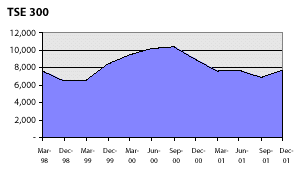
The Fund's actual rate of return over the quarter from Canadian equities was 13.6% or 70 basis points above the benchmark TSE 300. Over-weight holdings in growth stocks contributed to the better performance.

Investments in Canadian equities rose to 19.7% or $2.4 billion of the Fund's total investments at December 31, 2001.

United
States Equity Investments
The United States stock market surged ahead this quarter similar to the Canadian stock market. The Standard & Poor 500 index, S&P 500, which measures the performance of the top 500 American companies, increased by 11.9% from the previous quarter end.
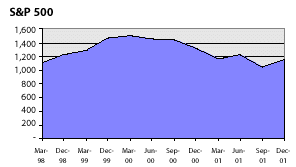
The Fund's actual rate of return over the quarter from US equities was 11.6% or 30 basis points less than the benchmark S&P 500. The underperformance was due to an under weight position in technology stocks.

Investments in United States equities rose to 14.7% or $1.8 billion of the Fund's total investments at December 31, 2001.

Europe,
Australasia and Far East (EAFE) Equity Investments
The non-North American equity markets gained ground this quarter. The Morgan Stanley Composite Index for Europe, Australasia and the Far East, MSCI EAFE, measures the performance of approximately 1000 companies on 21 stock exchanges around the world. The index increased by 8.1% this quarter end.

The Fund's actual rate of return over the quarter from non-North American equities was 7.4% or 70 basis points less than the benchmark MSCI EAFE index. The under performance was due to an under- weight position in technology stocks, which performed strongly in this quarter.
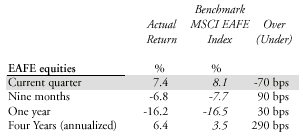
Investments in non-North American companies rose to 14.9% or $1.8 billion of the Fund's total investments at December 31, 2001.

Real
Estate Investments
The real estate market in Canada continued to provide a positive return this quarter. The Russell Canadian Property Index, which measures the performance of institutionally held real estate investments situated across Canada, grew by 2.4% during the quarter based on estimated results.
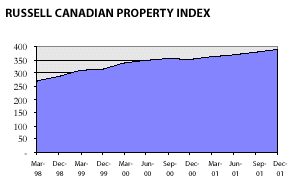
The rate of return this quarter from the Fund's real estate portfolio was 2.4%.

Investments in real estate rose to 4.9% or
$593 million of the Fundís total investments at December 31, 2001.

Business
Plan Performance Measures
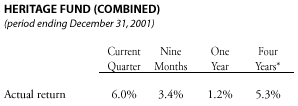
The combined rate of return is determined by adding the proportionate market value returns of each portfolio and adjusting for the timing of cash flows from the Transition Portfolio to the Endowment Portfolio.

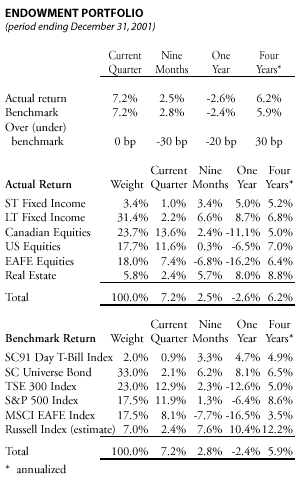

Administrative
Expenses
Administrative expenses include investment management, cash management, custodial and other expenses. External management and custodial fees are deducted directly from the income of the externally managed pooled funds. Internal administrative expenses are deducted from the internally managed pooled funds and directly from the Endowment Portfolio and the Transition Portfolio.

The increase in administrative expenses is related to the transfers from the Transition Portfolio to the Endowment Portfolio. The Endowment Portfolio is more expensive to administer because it is predominantly invested in equities, a large portion of which are foreign equities that are externally managed.

Financial Statements

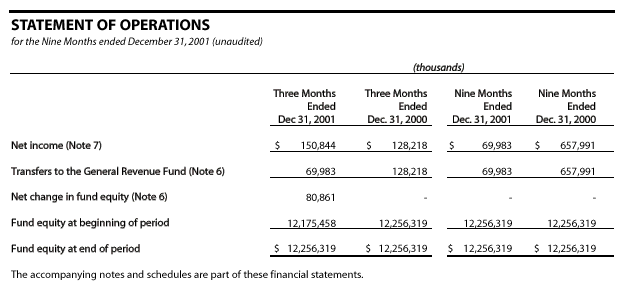
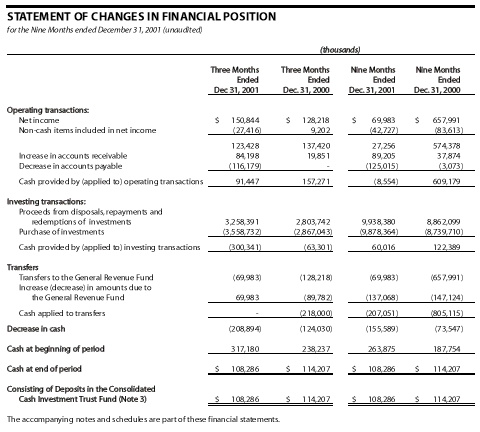
Notes to the
Financial Statements
December 31, 2001 (unaudited)
Note 1
Authority and Mission
The Alberta Heritage Savings Trust Fund operates under the authority of the Alberta Heritage Savings Trust Fund Act (the Act), Chapter A-23, Revised Statutes of Alberta 2000, as amended.
The preamble to the Act describes the mission of the Fund as follows:
"To provide prudent stewardship of the savings from Alberta's non-renewable resources by providing the greatest financial returns on those savings for current and future generations of Albertans."
As a result of amendments to the Fund's act on January 1, 1997, investments of the Fund are held in two portfolios, the Endowment Portfolio and the Transition Portfolio. Based on current transfers of $300 million per month, substantially all of the assets in the Transition Portfolio will be transferred to the Endowment Portfolio by June 30, 2002. These financial statements present the Fund's investments held in the two portfolios on a combined basis (see note 3 and note 3(s)).
Note 2 Summary of Significant Accounting
Policies and Reporting Practices
These financial statements are prepared in accordance with generally accepted accounting principles.
The accounting policies of significance to the Fund are as follows:
(a) Portfolio investments
Fixed-income securities, mortgages, equities, and real estate investments held directly by the Fund or by pooled investment funds are recorded at cost. Cost includes the amount of applicable amortization of discount or premium using the straight-line method over the life of the investments.
Investments in loans are recorded at cost less any allowance for credit loss. Where there is no longer reasonable assurance of timely collection of the full amount of principal and interest of a loan, a specific provision for credit loss is made and the carrying amount of the loan is reduced to its estimated realizable amount.
Investments are recorded as of the trade date.
The cost of disposals is determined on the average cost basis.
Where there has been a loss in value of an investment in fixed-income securities, mortgages, equities and real estate that is other than a temporary decline, the investment is written down to recognize the loss. The written down value is deemed to be the new cost.
(b) Investment Income
Investment income is recorded on the accrual basis where there is reasonable assurance as to its measurement and collectability. When a loan becomes impaired, recognition of interest income in accordance with the terms of the original loan agreement ceases. Any subsequent payments received on an impaired loan are applied to reduce the loan's book value.
Gains and losses arising as a result of disposals of investments are included in the determination of investment income. Income and expense from derivative contracts are included in investment income.
(c) Foreign Currency
Foreign currency transactions are translated into Canadian dollars using average rates of exchange, except for hedged foreign currency transactions which are translated at rates of exchange established by the terms of the forward exchange contracts. Exchange differences on unhedged transactions are included in the determination of investment income.
(d) Investment Valuation
Fair value is the amount of consideration agreed upon in an arm's length transaction between knowledgeable, willing parties who are under no compulsion to act. Fair values of investments held either directly by the Fund or by pooled investment funds are determined as follows:
(i) Public fixed-income securities and equities are valued at the period-end closing sale price, or the average of the latest bid and ask prices quoted by an independent securities valuation company.
(ii) Mortgages, provincial corporation debentures and private fixed-income securities are valued based on the net present value of future cash flows. These cash flows are discounted using appropriate interest rate premiums over similar Government of Canada benchmark bonds trading in the market.
(iii) The fair value of private equities is estimated by management.
(iv) Real estate investments are reported at their most recent appraised value, net of any liabilities against the real property. Real estate properties are appraised annually by qualified external real estate appraisers.
(v) Fair value of loans are reported at cost due to there being no organized financial market for the instruments and it is not practical within constraints of timeliness or cost to determine the fair values with sufficient reliability.
(vi) The fair value of deposits, receivables, accrued interest and payables are estimated to approximate their book values.
(vii) The fair value of investments and any other assets and liabilities denominated in a foreign currency are translated at the period-end exchange rate.
(e) Valuation of Derivative Contracts
Derivative contracts include equity and bond index swaps, interest rate swaps, forward foreign exchange contracts, equity index futures contracts and cross-currency interest rate swaps. As disclosed in Note 4, the value of derivative contracts is included in the fair value of pooled investment funds. The estimated amount receivable or payable from derivative contracts at the reporting date is determined by the following methods:
(i) Equity and bond index swaps are valued based on changes in the appropriate market based index net of accrued floating rate interest.
(ii) Interest rate swaps are valued based on discounted cash flows using current market yields.
(iii) Forward foreign exchange contracts and equity index futures contracts are based on quoted market prices.
(iv) The value of cross-currency interest rate swaps is included with the value of the underlying security. Cross-currency fixed to fixed interest rate swaps are valued at quoted prices based on discounted cash flows using current market yields. Cross- currency fixed to floating interest rate swaps are valued at the principal amount plus accrued interest.
Note 3 Portfolio
Investments

The majority of the Fund's investments are held in pooled investment funds established and administered by Alberta Revenue. Pooled investment funds have a market based unit value that is used to allocate income to participants and to value purchases and sales of pool units. As at December 31, 2001, the Fund's percentage ownership, at market, in pooled investment funds is as follows:

(a) The Consolidated Cash Investment Trust Fund is managed with the objective of providing competitive interest income to depositors while maintaining appropriate security and liquidity of depositors' capital. The portfolio is comprised of high-quality short-term and mid-term fixed-income securities with a maximum term-to-maturity of five years. As at December 31, 2001, securities held by the Fund have an average effective market yield of 2.24% per annum (March 31, 2001: 5.09% per annum).
(b) As at December 31, 2001, fixed-income securities held directly by the Fund have an average effective market yield of 2.24% per annum for securities maturing within a year (March 31, 2001: 5.01% per annum), and 4.27% per annum for securities maturing between 1 and 35 years (March 31, 2001: 5.10% per annum). As at December 31, 2001, fixed-income securities have the following term structure based on principal amount: under 1 year: 72%; 1 to 5 years: 27%; and over 5 years: 1%.
(c) The Canadian Dollar Public Bond Pool is managed with the objective of providing above average returns compared to the total return of the Scotia Capital Universe Bond Index over a four-year period while maintaining adequate security and liquidity of participants' capital. The excess return is achieved through management of portfolio duration and sector rotation. The portfolio is comprised of high quality Canadian fixed-income instruments and debt related derivatives. As at December 31, 2001, securities held by the Pool have an average effective market yield of 5.34% per annum (March 31, 2001: 5.75% per annum) and the following term structure based on principal amount: under 1 year: 4%; 1 to 5 years: 35%; 5 to 10 years: 31%; 10 to 20 years: 12%; over 20 years: 18%.
(d) The Private Mortgage Pool is managed with the objective of providing investment returns higher than attainable from the Scotia Capital Universe Bond Index over a four-year period or longer. The portfolio is comprised primarily of high quality commercial mortgage loans (94.8%) and provincial bond residuals (5.2%). To limit investment risk, mortgage loans are restricted to first mortgage loans, diversified by property usage and geographic location, and include a small portion of NHA insured loans. As at December 31, 2001, securities held by the Pool have an average effective market yield of 6.47% per annum (March 31, 2001: 7.14% per annum) and the following term structure based on principal amount: under 1 year: 15%; 1 to 5 years: 17%; 5 to 10 years: 22%; 10 to 20 years: 26%; and over 20 years: 20%.
(e) As at December 31, 2001, Provincial corporation debentures have an average effective market yield of 8.0% per annum (March 31, 2001: 7.84% per annum). The maturity profile based on expected repayments is as follows: under 1 year $59,437,000; 1 to 5 years: $26,562,000; and over 5 years: $74,901,000.
(f) Investment in loans are recorded at cost. The fair value of loans are reported at cost due to there being no organized financial market for the instruments and it is not practical within constraints of timeliness or cost to determine the fair values with sufficient reliability. As at December 31, 2001, investment in loans, at cost, include the Ridley Grain loan amounting to $91,245,000 (March 31, 2001: $91,245,000) and the Vencap loan amounting to $6,114,000 (March 31, 2001: $6,114,000).
- Under the terms of the loan to Ridley Grain, 11% Participating First Mortgage Bonds due July 31, 2015, interest is compounded semi- annually and payable annually to the extent of available cash flow and any shortfall is to be deferred and capitalized. The principal of $91,245,000 and deferred interest is repayable on or before July 31, 2015. Deferred interest at December 31, 2001 amounted to $60,049,081 (March 31, 2001: $55,125,291). Grain throughput volumes are the main determinant of profitability of the grain terminal and the value of the loan to the Fund. Due to the uncertainty of forecasting the grain throughput volumes, income from the participating bonds is recognized when it is measurable and collectable.
- The principal amount of the Vencap loan, amounting to $52,588,000, is due July 2046 and bears no interest. Amortization ceased being recorded on the loan from December 31, 2000 onward.
(g) The Domestic Passive Equity Pooled Fund is managed on a passive approach with the objective of providing investment returns comparable to the Toronto Stock Exchange (TSE) 300 Index. A portion of the portfolio is comprised of both publicly traded Canadian equities and structured investments replicating the TSE 100 Index and the TSE 60 Index. The other portion of the portfolio fully replicates the TSE 300. The Pool's investment in units of the Floating Rate Note Pool (FRNP) are used as the underlying securities to support the index swaps of the pool. FRNP is managed with the objective of generating floating rate income needed for the swap obligations in respect of structured investments in foreign equities, domestic equities and domestic bonds. Through the use of interest rate swaps, FRNP provides investment opportunities in high quality floating-rate instruments with remaining term-to-maturity of ten years or less.
(h) The Canadian Pooled Equity Fund is managed with the objective of providing competitive returns comparable to the total return of the Toronto Stock Exchange 300 Index while maintaining maximum preservation of participants' capital. The portfolio is comprised of publicly traded equities in Canadian corporations. Risk is reduced by prudent security selection and sector rotation.
(i) The Canadian Large Cap Equity Pool consists of multiple portfolios of publicly traded Canadian equities. Each portfolio is actively managed by an external manager with expertise in the Canadian large cap equity market. The performance objective is to provide returns higher than the total return of the TSE 300 index over a four-year period. Return volatility is reduced through multiple manager investment style and market capitalization focus.
(j) The Canadian Small Cap Equity Pool consists of multiple portfolios of publicly traded Canadian equities with market capitalization of .15% of the TSE 300 Index total market capitalization at time of purchase. Each portfolio is actively managed by an external manager with expertise in the Canadian small cap equity market. The performance objective is to provide returns higher than the total return of the TSE 300 index over a four-year period and returns higher than the Nesbitt Burns Small Cap Index over shorter time periods. Return volatility is reduced through multiple manager investment style and small capitalization focus.
(k) The Private Equity Pool (98) is managed with the objective of providing investment returns higher than attainable from the TSE 300 Index over a five to ten year period. The portfolio is comprised of investments in institutionally sponsored private equity pools. Risk is reduced by avoiding direct investments in private companies and by limiting holdings in any single pool. The Private Equity Pool is in the process of orderly liquidation.
(l) The US Large Cap Equity Pool consists of multiple portfolios of publicly traded United States equities. Each portfolio is actively managed by an external manager with expertise in the US large cap equity market. The performance objective is to provide returns higher than the total return of the Standard & Poor's (S&P) 500 index over a four-year period. Return volatility is reduced through multiple manager investment style and large capitalization focus.
(m) The US Passive Equity Pool consists of units in an externally managed US Passive Equity Pool that replicates the Standard & Poor's (S&P) 500 index. The performance objective is to provide returns comparable to the total return of the S&P 500 index over a four-year period.
(n) The US Small/Mid Cap Equity Pool consists of one portfolio of publicly traded United States equities. The portfolio is actively managed by an external manager with expertise in the small cap and mid cap US equity market. The performance objective is to provide returns higher than the total return of the Russell 2500 index over a four-year period.
(o) The Europe, Australasia and Far East (EAFE) Core and Plus Equity Pools consist of multiple portfolios of publicly traded non-North American equities. EAFE Core portfolios are actively managed by external managers with European and Pacific Basin mandates. EAFE core managers have constraints on foreign currency management and deviations from the MSCI EAFE index asset mix by country. The EAFE Plus portfolios are actively managed by external managers with less constraints on country allocation, stock selection, currency management and investments in emerging markets. The performance objective is to provide returns higher than the total return of the Morgan Stanley Capital International (MSCI) EAFE index over a four-year period.
(p) The externally managed EAFE Passive Equity Pool consists of one portfolio of non-North American publicly traded equities that replicate the MSCI EAFE index. The performance objective is to provide returns comparable to the total return of the MSCI EAFE index over a four-year period.
(q) The Private Real Estate Pool is managed with the objective of providing investment returns comparable to the Russell Canadian Property Index over a four-year period or longer. Real estate is held through intermediary companies which have issued to the Pool, common shares and participating debentures secured by a charge on real estate. Risk is reduced by investing in properties that provide diversification by geographic location, by property type and by tenancy. As real estate returns are positively correlated to inflation and negatively correlated to returns from fixed income securities and equities, the Pool provides diversification from the securities market with opportunities for high return.
(r) Where there has been a loss in value of an investment that is other than a temporary decline, the cost of the investment is written down to recognize the loss (see Note 2 (a)). Where the fair value remains less than cost, after recording a writedown, it is management's best judgement that the decline in value is caused by short term market trends and are temporary in nature.
(s) A summary of investments held in the Endowment Portfolio and Transition Portfolio is as follows:

Note 4 Derivative Contracts
Derivative contracts are financial contracts, the value of which is derived from the value of underlying assets, indices, interest rates or currency rates. The Fund uses derivative contracts held indirectly through pooled investment funds to enhance return, manage exposure to interest rate risk and foreign currency risk and for asset mix management purposes. The notional value of a derivative contract represents the amount to which a rate or price is applied in order to calculate the exchange of cash flows.
(i) A swap is a contractual agreement between two counter-parties to exchange a series of cash flows based on a notional amount. An equity or bond index swap involves the exchange of a floating interest rate cash flow for one based on the performance of a market index. For interest rate swaps, parties generally exchange fixed and floating rate interest cash flows based on a notional amount. Cross-currency interest rate swaps are contractual obligations in which the principal amounts of Canadian fixed-income securities denominated in foreign currency are exchanged for Canadian currency amounts both initially and at maturity. Over the term of the cross-currency swap, counter-parties exchange fixed to fixed and fixed to floating interest rate cash flows in the swapped currencies. There are underlying securities supporting all swaps. Leveraging is not allowed.
(ii) Foreign exchange contracts are contractual agreements to exchange specified currencies at an agreed upon exchange rate and on an agreed settlement date in the future.
(iii) A stock index futures contract is an agreement to receive or pay cash based on changes in the level of the specified stock index.
The following is a summary of the fund's proportionate share of the notional amount and fair value of derivative contracts held by pooled funds at December 31, 2001.

All derivative contracts mature within one year except for bond index swaps, cross-currency swaps and interest rate swaps with a notional value of $172,153,000 (March 31, 2001: $294,850,000) that mature between 1 and 3 years and $200,402,000 (March 31, 2001: $208,033,000) that mature over 3 years.
Note 5 Investment Risk
Management
Income and financial returns of the Fund are exposed to credit risk, price risk and operational risk. Credit risk relates to the possibility that a loss may occur from the failure of another party to perform according to the terms of a contract. Price risk is comprised of currency risk, interest rate risk and market risk. Currency risk relates to the possibility that the investments will change in value due to future fluctuations in foreign exchange rates. Interest rate risk relates to the possibility that the investments will change in value due to future fluctuations in market interest rates. Market risk relates to the possibility that the investments will change in value due to future fluctuations in market prices. Operational risk relates to internal practices, policies and systems and their ability to cope with adverse market conditions or human and technological error.
The Standing Committee on the Alberta Heritage Savings Trust Fund reviews and approves the business plan of the Fund. In order to earn an optimal financial return at an acceptable level of risk, the 2001-2002 business plan limits investments of the Transition Portfolio to include only fixed-income securities other than securities transferred from the previous structure and proposes the following asset mix policy for the Endowment Portfolio.
Endowment Portfolio:
Fixed income securities 25% to 45%
Equities and real estate 75% to 55%
The actual endowment portfolio asset mix is disclosed in note 3(s).
Risk is reduced through asset class diversification, diversification within each asset class, quality and duration constraints on fixed-income instruments, and restrictions on amounts exposed to countries designated as emerging markets. Controls are in place respecting the use of derivatives (see Note 4). Forward foreign exchange contracts may be used to manage currency exposure in connection with securities purchased in foreign currency (see Note 4).
Note 6 Fund Equity
Section 8 (2) of the Alberta Heritage Savings Trust Fund Act
(the Act) states that the net income of the Heritage Fund less any amount retained in the Fund to maintain its value shall be transferred to the General Revenue Fund annually in a manner determined by the Minister of Revenue. Net losses carried forward by the Fund from the six months ended September 30, 2001 totalling $80,861,000 have been used to reduce transfers to the General Revenue Fund for the quarter ended December 31, 2001.
Section 11(5) of the Act states that for fiscal years subsequent to 1999 and until the accumulated debt is eliminated in accordance with the
Fiscal Responsibility Act, the Minister of Revenue is not required to retain any income in the Heritage Fund to maintain its value, but may retain such amounts as the Minister of Revenue considers advisable.
Note 7 Net Income

Investment income is comprised of interest, dividends, amortization of discount and premiums, swap income, security lending income and realized gains and losses, net of write-downs, on investments. The Fund's share of income earned from externally and internally managed investment pools is net of administrative expenses incurred by the pools. (see Note 8).
Investment income for the nine months ended December 31, 2001 includes a net loss from disposals of investments and writedowns totalling $370,423,000 (December 31, 2000: net gain $231,973,000).
A summary of investment income (loss) earned in the Endowment Portfolio and Transition Portfolio is as follows:

Note 8 Administrative
Expenses
Administrative expense includes investment management, cash management, safekeeping costs and other expenses charged on a cost-recovery basis directly from Alberta Revenue. The Fund's total administrative expense for the period, including amounts deducted directly from investment income of pooled funds is as follows:

Note 9 Comparative
Figures
Certain comparative figures have been reclassified to conform to December 31, 2001 presentation.
Note 10 Approval of Financial
Statements
These financial statements were approved by the Deputy Minister of Revenue.

|






























